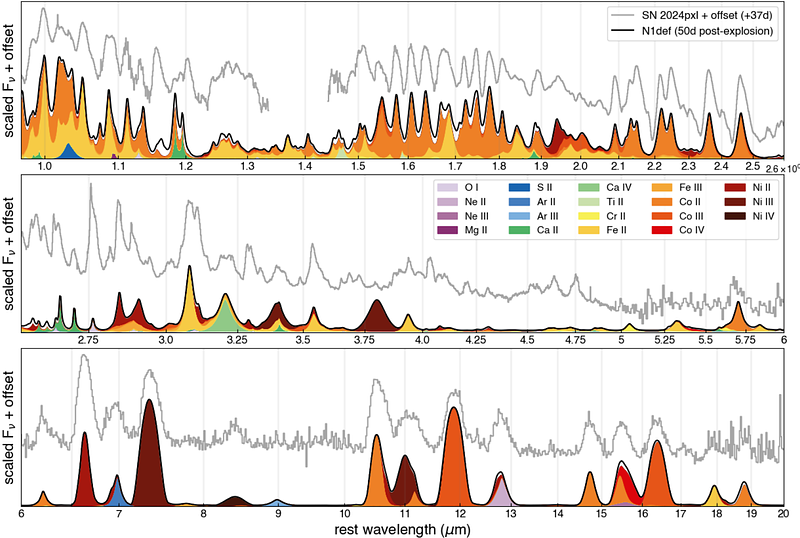JWST and Ground-based Observations of the Type Iax Supernovae SN 2024pxl and SN 2024vjm: Evidence for Weak Deflagration Explosions

JWST and Ground-based Observations of the Type Iax Supernovae SN 2024pxl and SN 2024vjm: Evidence for Weak Deflagration Explosions
Lindsey A. Kwok, Mridweeka Singh, Saurabh W. Jha, Stéphane Blondin, Raya Dastidar, Conor Larison, Adam A. Miller, Jennifer E. Andrews, Moira Andrews, G. C. Anupama, Katie Auchettl, Dominik Bánhidi, Barnabas Barna, K. Azalee Bostroem, Thomas G. Brink, Régis Cartier, Ping Chen, Collin T. Christy, David A. Coulter, Sofia Covarrubias, Kyle W. Davis, Connor B. Dickinson, Yize Dong, Joseph R. Farah, Alexei V. Filippenko, Andreas Flörs, Ryan J. Foley, Noah Franz, Christoffer Fremling, Lluís Galbany, Anjasha Gangopadhyay, Aarna Garg, Peter Garnavich, Elinor L. Gates, Or Graur, Alexa C. Gordon, Daichi Hiramatsu, Emily Hoang, D. Andrew Howell, Brian Hsu, Joel Johansson, Arti Joshi, Lordrick A. Kahinga, Ravjit Kaur, Sahana Kumar, Piramon Kumnurdmanee, Hanindyo Kuncarayakti, Natalie LeBaron, Chang Liu, Keiichi Maeda, Kate Maguire, Curtis McCully, Darshana Mehta, Luca M. Menotti, Anne J. Metevier, Kuntal Misra, C. Tanner Murphey, Megan Newsome, Estefania Padilla Gonzalez, Kishore C. Patra, Jeniveve Pearson, Anthony L. Piro, Abigail Polin, Aravind P. Ravi, Armin Rest, Nabeel Rehemtulla, Nicolas Meza Retamal, Olivia M. Robinson, César Rojas-Bravo, Devendra K. Sahu, David J. Sand, Brian P. Schmidt, Steve Schulze, Michaela Schwab, Manisha Shrestha, Matthew R. Siebert, Sunil Simha, Nathan Smith, Jesper Sollerman, Bhagya M. Subrayan, Tamás Szalai, Kirsty Taggart, Rishabh Singh Teja, Tea Temim, Jacco H. Terwel, Samaporn Tinyanont, Stefano Valenti, Jorge Anais Vilchez, József Vinkó, Aya L. Westerling, Yi Yang, WeiKang Zheng
AbstractWe present panchromatic optical $+$ near-infrared (NIR) $+$ mid-infrared (MIR) observations of the intermediate-luminosity Type Iax supernova (SN Iax) 2024pxl and the extremely low-luminosity SN Iax 2024vjm. JWST observations provide unprecedented MIR spectroscopy of SN Iax, spanning from $+$11 to $+$42 days past maximum light. We detect forbidden emission lines in the MIR at these early times while the optical and NIR are dominated by permitted lines with an absorption component. Panchromatic spectra at early times can thus simultaneously show nebular and photospheric lines, probing both inner and outer layers of the ejecta. We identify spectral lines not seen before in SN Iax, including [Mg II] 4.76 $\mu$m, [Mg II] 9.71 $\mu$m, [Ne II] 12.81 $\mu$m, and isolated O I 2.76 $\mu$m that traces unburned material. Forbidden emission lines of all species are centrally peaked with similar kinematic distributions, indicating that the ejecta are well mixed in both SN 2024pxl and SN 2024vjm, a hallmark of pure deflagration explosion models. Radiative transfer modeling of SN 2024pxl shows good agreement with a weak deflagration of a near-Chandrasekhar-mass white dwarf, but additional IR flux is needed to match the observations, potentially attributable to a surviving remnant. We favor a weak deflagration origin for SN 2024vjm because of its panchromatic spectral similarity to SN 2024pxl, despite the large difference in luminosity. However, our comparison weak deflagration models are all too luminous and rapidly fading compared to SN 2024vjm; future modeling should push to even weaker explosions and include the contribution of a bound remnant. Our observations demonstrate the diagnostic power of panchromatic spectroscopy for unveiling explosion physics in thermonuclear supernovae.